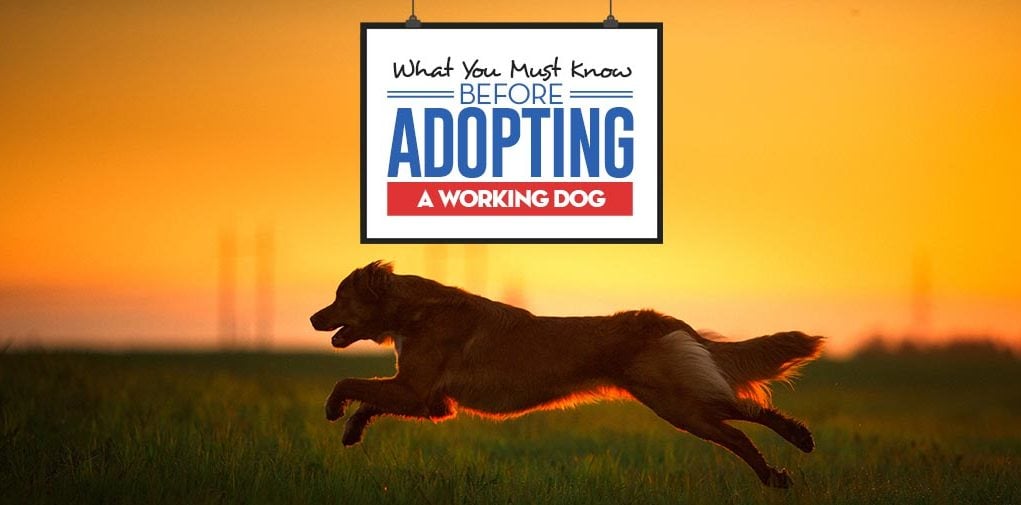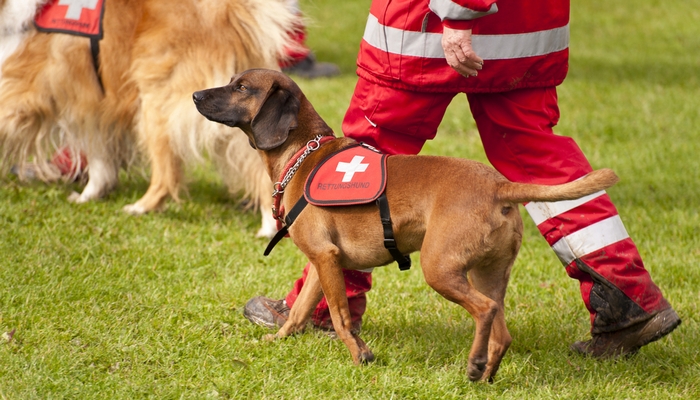As a potential dog owner, it can be very confusing when trying to match a specific dog breed with your lifestyle. This especially true if you're looking to adopt a working dog, so there will be concerns over his daily schedule compared to “regular” dogs: feeding, exercise requirements and more.
To ensure a healthy and happy lifestyle for the dog (and yourself), it's crucial to address the needs of your specific dog. For example, canine athletes have different nutrition and exercise requirements than pets who are simply your loyal home pals.
So let's discuss exactly what you need to know before you adopt a working dog.
Say you’ve already decided to adopt a canine, and now you’re thinking of breed, size, personality type and the activity level you can accommodate with your own lifestyle. Your choice of dog will also depend on the needs of your family and the size of your home. You need to begin by understanding the “types” of dogs that are out there.
What type of dog will you adopt?
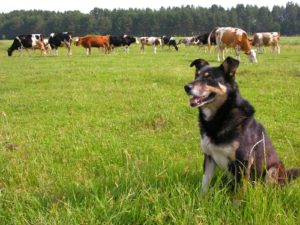 Dauntingly, there are around 400 dog breeds in the world, with 189 officially recognized in the United States by the American Kennel Club. This breeds list is categorized by type or class, based on why they were bred, their traits and personalities, and performance.
Dauntingly, there are around 400 dog breeds in the world, with 189 officially recognized in the United States by the American Kennel Club. This breeds list is categorized by type or class, based on why they were bred, their traits and personalities, and performance.
Some of these dog breed classes include herding dogs, working dogs, toy, terrier and hound breeds., among others. To make things even more interesting, dogs can be classed differently by kennel clubs based on their specific breed standards. It's a good idea that you pick the type of dog that will fit your daily routine and lifestyle.
How are you supposed to pick a dog that will match your lifestyle? Here's an example.
Let’s say you’re a very active person who enjoys outdoors – hiking, long walks, nature, adventure and so on. It’s likely you will want to adopt a dog who can share these outings and activities with you, and won't be lazy.
Or, perhaps you’re looking for a loyal and protective companion who can help protect your home or properties. In this case you'll need a dog that's a good, protective guard dog and not befriends everybody around.
This brings us to the Working Dog class of canines.
Working dogs have been defined by the AKC as having been “invaluable assets to man throughout the ages.” Intelligent and quick to learn, they also make “solid companions”, having been bred to perform such jobs as guarding property, pulling sleds, herding farm animals, and performing water rescues.
All of these working dogs have strong and amazingly unique personalities with their own special set of skills. They are well suited to people who can be equally strong and a real pack leader to help shape their behavior in positive ways.
It’s important to remain consistent with a working dog's training, encouraging and challenging these dogs to compliment their natural abilities and intelligence. When adopting a working dog, you’ve decided to invest in having a trusting partner and faithful furry friend who is likely to help you out with certain tasks. Here's what you must know.
ALSO READ: 16 Commands You Must Teach Your Dog After Adopting
How to Prepare for Adopting a Working Dog
What is a working class dog?
A few more things you should know about the working dog type/class. There are some 30 breeds in this group, the classification of which changes based on country and specific kennel club organizations worldwide.
Some of the popular working dog breeds include:
- Dobermans
- Boxers
- Siberian Husky
- Great Dane
- Rottweiler
- Bernese Mountain Dog
- Mastiff
- St. Bernard
- Schnauzer
- Collies (classified in Australia and New Zealand as such)
- Portuguese Water Dog
In appearance and history, these working dogs are all over the map and have been involved in many different jobs as assistants to their humans. But, they have many traits in common that, once learned, will help you to train them effectively as well as understand their personalities and intentions.
Keep in mind that working dogs are canines with a innate sense of purpose.
This means that not only they have the desire and skills for certain tasks, but that you must provide them with these tasks to prevent restlessness and bad behavior.
A working dog's strong personality is well suited to always having a job to do. The job they will do best will also depend on the balance of their specific other breed traits.
For instance, a Doberman is one of the most loyal protectors in this class and well suited to being a guardian, while a Bernese Mountain Dog, Boxers or a Portuguese Water Dog are better when given specific tasks like finding a hidden object or person. Many of these dogs are often classified as great canines for police work.
In general, working dog breeds are very focused on their tasks, which can be ideal for some owners, but also present a challenge during dog training. Their stubborn nature and intelligence requires both consistency and experience in training, as these breeds typically resist a harsher demand to perform or do a task (e.g. negative reinforcement training).
It’s better to reward their good behavior and have patience. They will, in turn, reward you by being a faithful and trustworthy companion, always focused on a task at hand.
The bottom line here is that if you are to adopt a working dog, then you should know what to expect and be well-versed in proper dog training techniques and be a good handler for these stubborn canines. You can always get some help from professional dog trainers, but you cannot completely avoid learning how to handle a working dog.
RELATED: 5 Best Service Dog Vests and Harnesses for Working Dogs
What about specific breed traits, and why do they matter?
First, the size matters. The class of working dogs is mostly made up of medium to large breeds. There are no small or toy dog breeds that are considered a “working dog.”
These sizes of large and medium dogs, regardless of their class, will require suitable housing environments and a solid pack structure. The latter is especially important, so your dog feels safe and secure within his role as your companion and/or helper.
Below I'm going to give you a few breeds as examples of working dogs and what kind of care and attention they require. Take these examples and make sure to research your own prospects thoroughly before you actually adopt a working dog.
Rottweilers as working dogs
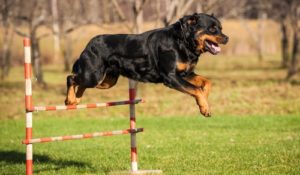 Rottweilers are a steadfast and hearty breed, with a history of being both a guard and herding dog. At one point, they were even used as a draft dog by butchers, pulling their carts during deliveries. Today, they are often used by professionals as police and border dogs, and in mountain rescue work.
Rottweilers are a steadfast and hearty breed, with a history of being both a guard and herding dog. At one point, they were even used as a draft dog by butchers, pulling their carts during deliveries. Today, they are often used by professionals as police and border dogs, and in mountain rescue work.
Rottweilers should be trained with these skills in mind, and their value as a guard dog can often be hindered by their herding and social traits. They are very social dogs who do better working with their owners as a partnership, rather than being left alone to guard a home or property. Rottweilers are one of the strongest breeds in this class, and therefore it’s important they be well trained and alert to your commands.
Finally, it's important to understand the personality trait of a Rottweiler who's a working dog. Statistically, they are one of the most aggressive dog breeds with a very high rate of biting people and other animals. This doesn't mean that every Rottweiler is dangerous, but it does mean that these dogs require a very experienced handler.
Siberian Huskies as working dogs
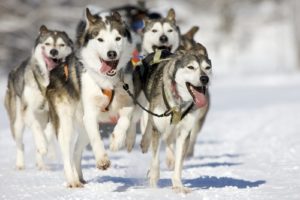 Siberian Huskies are often adopted due to their looks and fame, as they are one of the most popular dog breeds on the planet. However, this breed is very much a working dog that requires special training and daily routine.
Siberian Huskies are often adopted due to their looks and fame, as they are one of the most popular dog breeds on the planet. However, this breed is very much a working dog that requires special training and daily routine.
The intelligence and diligent nature of working dogs requires consistent training and nurturing of specific positive skills. Huskies can become bored easily, and that boredom can lead to destructiveness and other bad behaviors. Siberian Huskies are notoriously high energy and need a lot of exercise to keep them happy and secure in their environment.
These dogs were bred to run for miles and have an immense drive and determination. These traits should be encouraged and directed into positive jobs or games that will occupy his mind and use his energy, like agility competitions. Due to their alert nature, they should be well socialized as puppies to people, noises, children and other dogs.
They are sensitively intelligent, but can be wary of new things. This can present a challenge if you're training them at an older age. The key is to remain patient, calm and praise them whenever they can relax around new stimuli.
Boxers as working dogs
 Originating in Germany, the Boxer is another very popular breed, known for their energy and inquisitive minds. They are loyal but also headstrong and sensitive, like many others in this class, and require lots of positive reinforcement training with praise. They’ve also had a role working with police and search and rescue teams, due to their courage, strength and intelligence.
Originating in Germany, the Boxer is another very popular breed, known for their energy and inquisitive minds. They are loyal but also headstrong and sensitive, like many others in this class, and require lots of positive reinforcement training with praise. They’ve also had a role working with police and search and rescue teams, due to their courage, strength and intelligence.
They can make great family dogs and have a history of being patient with children as well as protecting their property from strangers. Due to their headstrong nature, Boxers should be well socialized with other dogs from a young age so they learn and play well with others. Be aware of their strengths and weaknesses, as there are many.
Border Collies as working dogs
Border Collies (and other Collie breeds) have been classified both in the working and herding classes by different kennel club organizations worldwide. I’ve included this breed in the article because they are quite popular and also one of the most intelligent dog breeds.
A Border Collie is a dog that's always on a mission. He really needs a purpose to be a well behaved and happy family pet. This breed would be ideal for very active owners who enjoy outdoor sports, and Border Collies excel at activities such as agility competitions.
They are fast learners and, similar to Huskies, become bored easily. Their energy must be channeled in a positive way so they do not become destructive. Their innate desire to herd can be directed through training, though they may instinctively want to herd children and other pets since that is what they were bred to do.
Extra large breed working dogs
Larger breeds in this class – like Bernese Mountain Dogs, St. Bernards and Great Danes – can still be quite active as young dogs and require a lot of space.
With these breeds, you'll need a large backyard or scheduled play sessions in fenced in off-leash or dog friendly neighborhood parks. You can play fun games with them, like sending them on “missions” by hiding objects for them to find.
These breeds are also tremendously loyal and have the instinct to protect. They should be encouraged to give warning barks, but also be well socialized to know the difference between friends and intruders.
The Bottom Line
 The key takeaway here is that specifically when it comes to adopting a working dog, every type and class of breed is different in their personalities, exercise requirements and what they're good at, and what they're poor at.
The key takeaway here is that specifically when it comes to adopting a working dog, every type and class of breed is different in their personalities, exercise requirements and what they're good at, and what they're poor at.
If you're looking to adopt a working dog whether because you simply love the breed or you need the dog's help with something, you must first research this dog breed to understand what it takes to care for this canine, and how to prevent any kind of bad behavior, aggressiveness and boredom in these dogs.
One of the key aspects of adopting a working dog is for you to consider your own lifestyle and how your future canine companion fits into that lifestyle: is he going to be a good addition to your family where you can all live in peace, or will he become a constant problem because of how different your life is compared to the dog's needs?
READ NEXT: The Science Behind Aggression in Dogs


